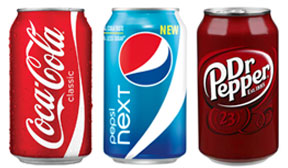 owdown in the North American beverage business has been blamed on the weather, the economy, consumer aversion to alternative sweeteners and obesity. Whatever the reason for the slowdown, it is clear companies such as the Dr Pepper Snapple Group, PepsiCo, Inc. and the Coca-Cola Co. are all struggling to identify the right formulas to unlock the potential in one of the world’s largest economies.
owdown in the North American beverage business has been blamed on the weather, the economy, consumer aversion to alternative sweeteners and obesity. Whatever the reason for the slowdown, it is clear companies such as the Dr Pepper Snapple Group, PepsiCo, Inc. and the Coca-Cola Co. are all struggling to identify the right formulas to unlock the potential in one of the world’s largest economies.“It should come as no surprise to anyone that this was a challenging quarter,” said Larry Young, president and chief executive officer of the Dr Pepper Snapple Group, Plano, Texas, in a conference call with securities analysts on July 24. “The headwinds facing the C.S.D. (carbonated soft drink) category continued. Consumers remain cautious, and the U.S. saw some of the coldest and wettest weather in recent years.”
With what he described as “increasing category headwinds” Mr. Young said his company must reinvigorate the C.S.D. category and bring lapsed and new consumers to the products. One of Dr Pepper’s solutions to bring back some of those customers has been the launch and development of its TEN line, which features C.S.D.s with only 10 calories.
Issues Mr. Young sees leading to the decline of C.S.D. consumption include obesity and sweeteners.
“When I talk about the headwinds, I look at what we keep getting hit with: Obesity, different municipalities that are trying to ban different size drinks or certain packages or sugared brands,” he said. “And then, also, we stay very concerned with the decline in diets. Our diets, you know, continue to perform below what we see in the category – (and it’s) not just ours; I'm talking about the entire category.”
Mr. Young then rhetorically asked – “Is that the sweeteners, what is it? That’s what we are trying to find out.”
PepsiCo, Inc., Purchase, N.Y., also is working to address a challenging North American market.
“We're making good progress in North American Beverages to accelerate innovation, improve our market-place execution, and drive productivity to improve our competitiveness and profitability,” said Indra Nooyi, chairman and chief executive officer, in a July 24 conference call with analysts. “But the fact remains that the beverage category in the U.S. has its challenges, especially carbonated soft drinks.”
Ms. Nooyi said to meet the challenges, PepsiCo has focused on repositioning its business for sustainable, long-term growth by improving marketplace execution and stepping up productivity.
“We are leveraging the strength of the portfolio which is well balanced between C.S.D.s and non-carbs,” she said. “We will continue to invest in breakthrough innovation and new technologies that have potential to reframe the beverage category, by removing some of the compromises that consumers face with regard to calories and ingredients. In addition, as we have said in the past, we are also exploring every possible alternative, including structural alternatives, to further improve our margins and returns in this business. And we will provide an update on our efforts in early 2014.”
Productivity will be a focus for PepsiCo as the company brings technologies in processing, packaging and ingredients online.
“So as we look at the productivity programs we have talked about the next tranche of productivity,” Ms. Nooyi said. “Some of that next tranche of productivity is from North American Beverages, and that comes from some of these technologies beginning to get implemented in the marketplace. And that's what gives us confidence that there are opportunities to improve margin performance.”
In a conference call on July 16, Muhtar Kent, chairman and c.e.o. of the Coca-Cola Co., Atlanta, said he is confident in his firm’s North American strategy, but he admitted the company still has work to do.
“We are building a balanced portfolio of strong brands, led by Coca-Cola, and ensuring that our portfolio remains relevant to all generations of consumers and across all beverage occasions,” he said. “Second, we are focused on translating this brand value into unsurpassed customer value by delivering best-in-class customer service each and every single day. And third, we are continuously investing to build the capabilities we will need to sustain and to repeat our success.
“These strategies are taking a real hold, and we are building on them with the evolution of the United States franchise system announced earlier this year. We therefore believe we are well-positioned to continue outperforming the nonalcoholic ready-to-drink beverage industry for the balance of the year.”
Carbonated soft drinks remained by far the biggest liquid refreshment beverage category, but they continued to lose both volume and market share in 2012, according to the Beverage Marketing Corp. (B.M.C.), New York. Volume slipped by 1.8% from 13.6 billion gallons in 2011 to 13.3 billion gallons in 2012, which lowered the category’s market share from 46% to less than 45%.
Niche categories outperformed traditional mass market categories, the B.M.C. said. Premium beverages such as ready–to–drink tea and coffee and, especially, energy drinks advanced during 2012. Aggressive pricing also contributed to a sizeable increase in bottled water volume during the year.





